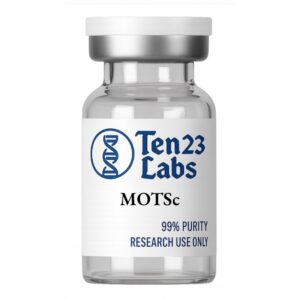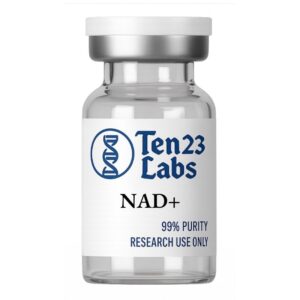
Mitochondrial Decline with Age: How NAD⁺ and MOTS-c May Offer a Research-Based Pathway to Cellular Renewal
As we age, many of the visible changes in our bodies—slower recovery, less energy, diminished endurance—are rooted in something happening at the microscopic level: mitochondrial decline.
Mitochondria are often called the “powerhouses of the cell” for a reason. Their main job is to generate ATP (adenosine triphosphate), the molecule that powers nearly every biological function. But over time, this energy production system becomes less efficient, contributing to the aging process and many age-associated declines in physical and cognitive function.
When Does Mitochondrial Decline Begin?
Mitochondrial efficiency and biogenesis (the formation of new mitochondria) peak in our 20s, and by the age of 30, measurable declines begin to occur. Research shows that:
Mitochondrial function declines by approximately 8% per decade after the age of 30
(Short et al., 2005, The Journal of Clinical Investigation, https://doi.org/10.1172/JCI23846)This means by age 50, mitochondrial capacity may be down by roughly 16%, and by age 70, it could be closer to 30–35%—depending on lifestyle and genetics.
This decline is tied to reduced expression of mitochondrial enzymes, accumulation of mitochondrial DNA mutations, and most notably, decreased availability of NAD⁺ (nicotinamide adenine dinucleotide).
Why NAD⁺ Is Essential
NAD⁺ is a coenzyme central to energy metabolism and mitochondrial function. It acts as a shuttle for electrons during ATP production and also regulates enzymes called sirtuins, which help maintain genomic stability and repair DNA.
As we age:
NAD⁺ levels can decline by as much as 50% between the ages of 40 and 60
(Yoshino et al., 2018, Cell Metabolism, https://doi.org/10.1016/j.cmet.2018.06.011)Lower NAD⁺ means decreased mitochondrial efficiency, slower cellular repair, and increased oxidative stress.
Researchers are now studying how NAD⁺ precursors or boosters may help restore mitochondrial function in aging tissues. In preclinical models, NAD⁺ restoration has shown improvements in muscle endurance, insulin sensitivity, and even cognitive performance—but these are research findings, not approved medical treatments.
Introducing MOTS-c: A Mitochondrial-Derived Peptide
Discovered in 2015, MOTS-c (Mitochondrial ORF of the Twelve S rRNA Type-c) is a small peptide encoded in mitochondrial DNA. It acts like a messenger, responding to cellular stress and helping regulate metabolism, particularly during times of low energy availability (like fasting or exercise).
Research insights:
MOTS-c increases glucose uptake and promotes mitochondrial homeostasis and biogenesis, making it of particular interest in aging models.
(*Lee et al., 2015, Cell Metabolism, https://doi.org/10.1016/j.cmet.2015.05.015)In mice, MOTS-c improved exercise capacity, reduced age-related insulin resistance, and supported healthy mitochondrial gene expression.
(Lu et al., 2019, Nature Communications, https://doi.org/10.1038/s41467-019-10685-1)
Again, while these studies are promising, MOTS-c is not an FDA-approved therapy. It is currently available only under research use only (RUO) models, and human trials are ongoing or in early stages.
The Synergistic Potential of NAD⁺ and MOTS-c (in Research)
Some emerging research suggests that NAD⁺ and MOTS-c may work synergistically in the following ways:
NAD⁺ supports sirtuins and mitochondrial enzyme function
MOTS-c supports mitochondrial gene expression and metabolic flexibility
Together, they may reinforce mitochondrial biogenesis, reduce oxidative stress, and improve the cellular stress response in aged cells
While we cannot claim therapeutic effects under the RUO framework, the combined use of NAD⁺ boosters (like NMN or NR) and MOTS-c peptides is being explored in academic and lab-based research settings for their potential to reverse aspects of mitochondrial aging.
Conclusion: A Promising Area of Ongoing Study
Mitochondrial decline is a hallmark of aging, and the associated drop in NAD⁺ levels and energy metabolism begins as early as our 30s. The mitochondrial peptide MOTS-c is an exciting new frontier in the quest to understand how cells regulate energy and stress responses over time.
Under the Research Use Only model, scientists and biohackers alike are investigating how compounds like NAD⁺ and MOTS-c might one day form the basis of targeted anti-aging protocols—but we’re not there yet. Still, the results from current studies are worth paying attention to, and future breakthroughs may change how we view aging at the cellular level.
To begin your research, check out the items below.

CoreHeal Bundle
CoreHeal is a targeted healing research stack combining two of...
MOTSc (20mg)
MOTS-c is primarily researched for its potential to regulate metabolic...
NAD+ (500mg)
NAD+ is primarily researched for its role in cellular energy...
Disclaimer:
The information provided in this article is for research and educational purposes only. Any compounds discussed, including NAD⁺ and MOTS-c, are intended for Research Use Only (RUO) and are not approved by the FDA for the diagnosis, treatment, cure, or prevention of any disease. This content does not constitute medical advice, and nothing herein should be interpreted as a recommendation or prescription. Always consult with a qualified healthcare professional before making any decisions related to your health or wellness.



